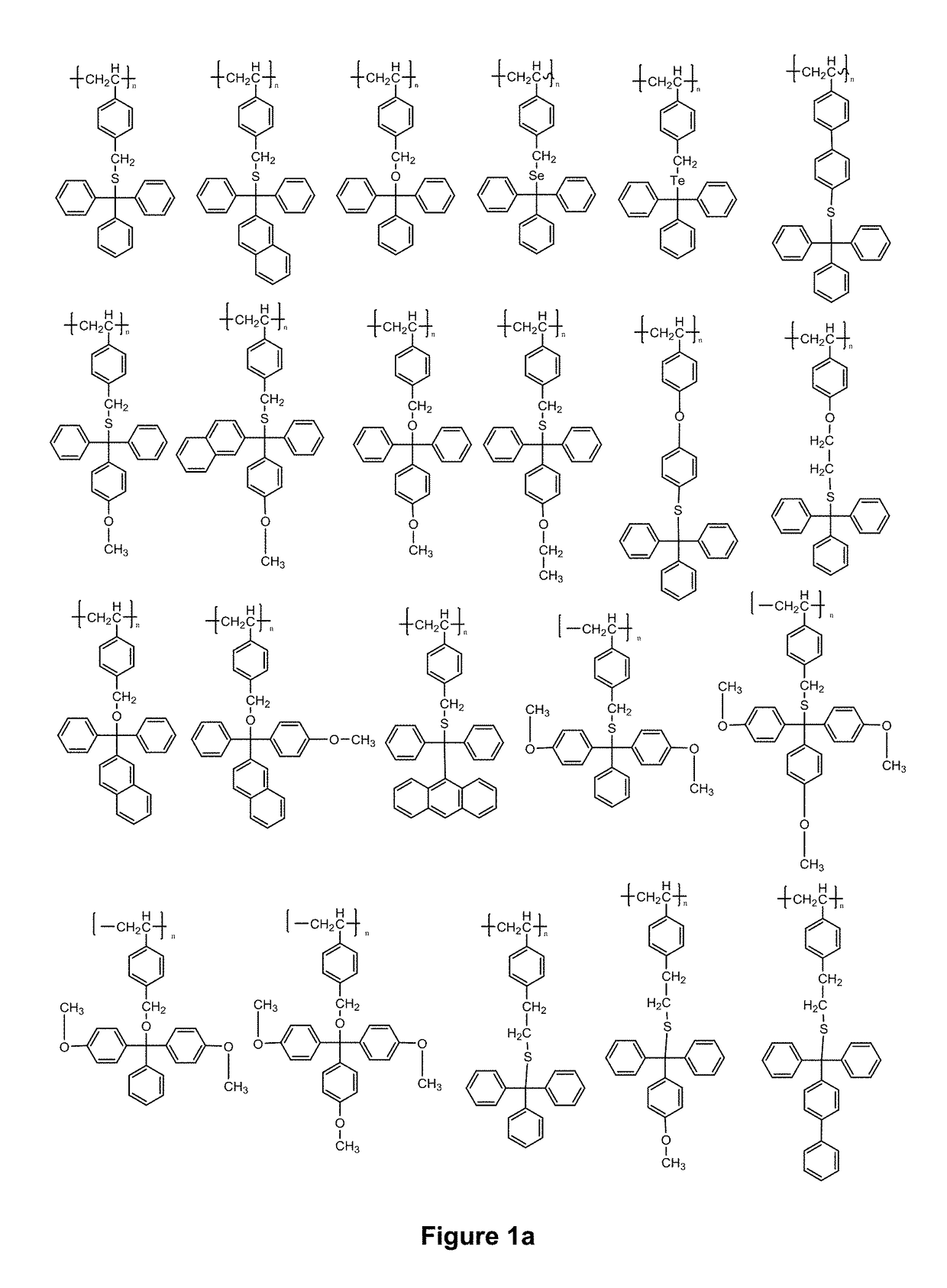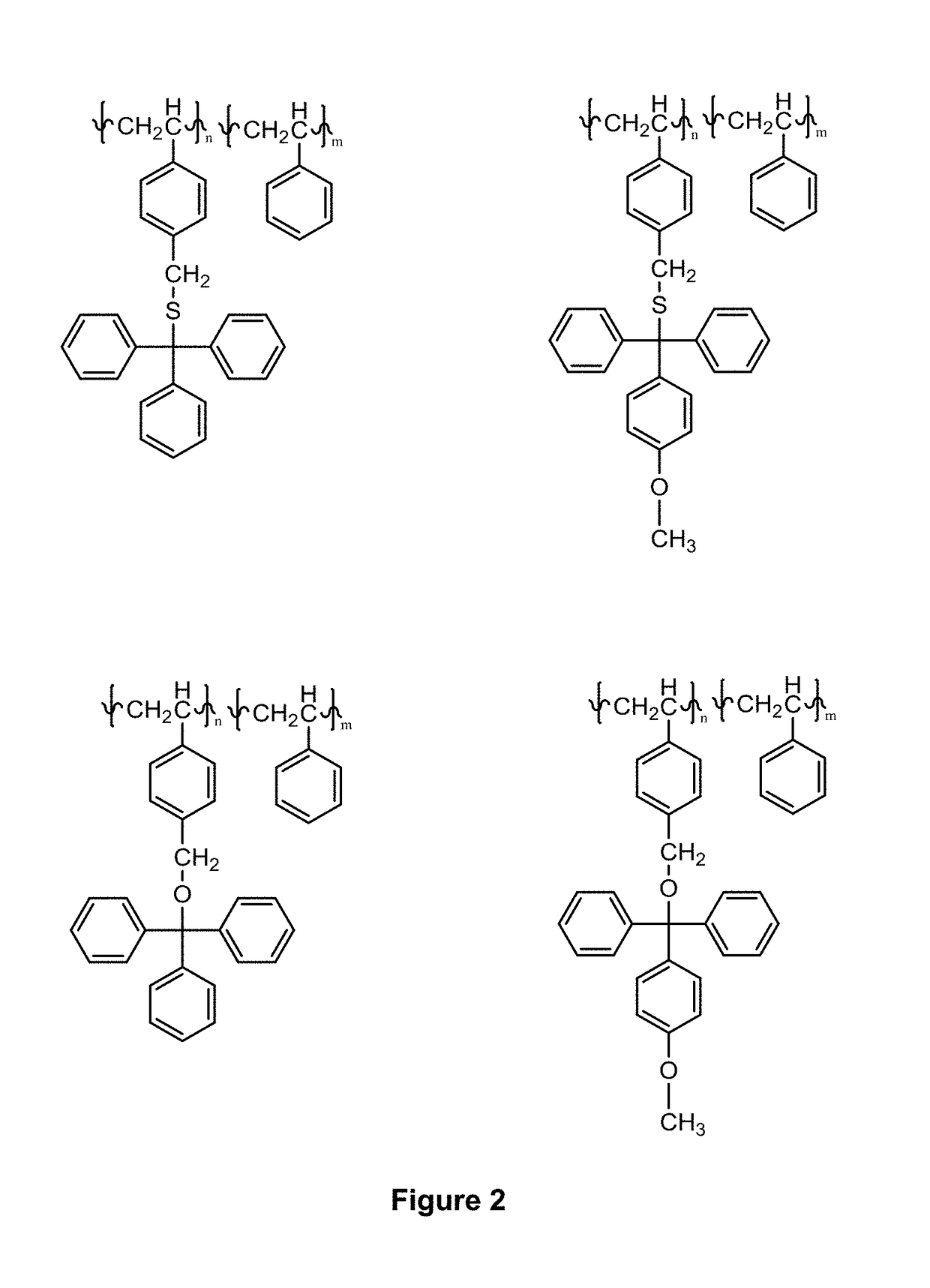Compositions and use thereof for modification of substrate surfaces
a technology of compositions and substrates, applied in the field of compositions, can solve the problems of difficult to achieve further reduction of pattern dimensions, limited dimensions of integrated circuit features, and regions exposed to radiation to become less removable with a developer solution or by conventional ic plasma processing
- Summary
- Abstract
- Description
- Claims
- Application Information
AI Technical Summary
Benefits of technology
Problems solved by technology
Method used
Image
Examples
synthesis example 2
(mmt=4-Monomethoxytrityl) (IX)
[0128]
[0129]A 3 L flask was charge with 60 g of sodium hydrosulfide hydrate dissolved in a mixture of 700 g acetone / 700 g water and this solution was degassed to remove air by bubbling into it N2. To this flask was then added 60 g of 4-monomethoxytrityl chloride dissolved in 250 g of warm acetone. The mixture was stirred at room temperature for 2 hrs. The formed mmt-SH solid was isolated by filtering and washed thoroughly by DI water and finally dried in a room temperature (rt) vacuum oven until constant weight to obtain 52 g mmt-SH. Proton NMR confirmed the structure (in CDCl3, 14 phenyl H at 6.8-7.4 ppm; 3H in —OCH3 at 3.8 ppm and 1H in SH at 3.15 ppm)
Synthesis Example 3: Synthesis of Polystyrene Endcapped with CH2CH2—S-mmt (mmt=4-Monomethoxytrityl) (X)
[0130]
[0131]Under nitrogen gas protection, 100.3 g of the polymer made in example 1 was dissolved in 460 g of methylene chloride and charged into a 3 L flask. To this was added 30 g of p-toluenesulfonyl...
synthesis example 4
r with the Following Structure (XI)
[0133]
[0134]In a flask equipped with a magnetic bar and a cold water condenser, 0.59 g of 2-chloroethyl methacrylate, 0.6 g of AIBN and 19.6 g of methyl methacrylate were dissolved in 45 g of methyl ethyl ketone and the solution was purged with nitrogen gas for 30 min. The flask was immersed in an 80° C. oil bath. The reaction was then kept at this temperature for 5 hrs. After cooling, the polymer solution was slowly poured into methanol with vigorous agitation. The polymer obtained was isolated by filtering and dried in a 45° C. vacuum oven until constant weight to obtain 15 g of white polymer.
[0135]Under the protection of a nitrogen atmosphere, 0.7 g of mmt-SH made in Synthesis Example 2 was dissolved in 3 g of THF, and then 1.78 g of 1M potassium tert-butoxide in THF was added to this solution. After stirring at rt for about 10 min, 8 g of the polymer as made above was dissolved in 20 g of THF and added to this solution. The resultant reaction m...
synthesis example 5
r with the Following Structure (XIII)
[0136]
[0137]In a flask equipped with a magnetic stirring bar and a cold water condenser, 0.66 g of 4-vinylbenzyl chloride, 1.0 g of AIBN and 20.4 g of styrene were dissolved in 45 g of methyl ethyl ketone and the solution was purged with nitrogen gas for 30 min. The flask was the immersed in a 80° C. oil bath. The reaction was kept at this temperature for 5 hrs. After cooling, the polymer solution was slowly poured into methanol with vigorous agitation. The polymer obtained was isolated by filtering and dried in a 45° C. vacuum oven until constant weight to obtain 11 g of white polymer.
[0138]Under nitrogen protection 0.71 g of mmt-SH made in Synthesis Example 2 was dissolved in 3 g of THF and 1.78 g of 1M potassium tert-butoxide in THF was added. After stirring at rt for about 10 min, 8 g of the polymer made above issolved in 20 g of THF was added. The reaction mixture was stirred at 50° C. for 24 hrs. The solution was then cooled and poured into...
PUM
| Property | Measurement | Unit |
|---|---|---|
| temperature | aaaaa | aaaaa |
| temperature | aaaaa | aaaaa |
| thickness | aaaaa | aaaaa |
Abstract
Description
Claims
Application Information
 Login to View More
Login to View More - R&D
- Intellectual Property
- Life Sciences
- Materials
- Tech Scout
- Unparalleled Data Quality
- Higher Quality Content
- 60% Fewer Hallucinations
Browse by: Latest US Patents, China's latest patents, Technical Efficacy Thesaurus, Application Domain, Technology Topic, Popular Technical Reports.
© 2025 PatSnap. All rights reserved.Legal|Privacy policy|Modern Slavery Act Transparency Statement|Sitemap|About US| Contact US: help@patsnap.com



